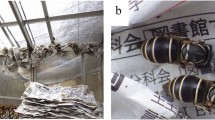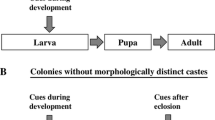Abstract
Colonies ofBelonogaster petiolata in Gauteng (South Africa) produced reproductive offspring (gynes and males) in late January and early February of each nesting season; their appearance was associated with a decline in worker and brood numbers. Brood decline could commence in the presence of a dominant, reproductively active queen, and loss or removal of the queen was not followed directly by cessation of nest growth and brood care. An older worker usually took over the α-position in queenless colonies. Several factors appear to contribute to brood decline and, ultimately, termination of the colony cycle in this species. These include (1) cessation of the supply of solid food to colonies (and particularly their larvae) during the reproductive phase, (2) a decrease in the worker/larva ratio during the latter phase due to the progressive loss of workers, (3) increasing number of gynes and males, and (4) an adult priority over food reception from foragers.
Similar content being viewed by others
References
Bohm, M. K., and Stockhammer, K. A. (1977). The nesting cycle of a paper wasp,Polistes metricus (Hymenoptera: Vespidae).J. Kans. Entomol. Soc. 50: 275–286.
Deleurance, E. P. (1952). Le polymorphisme sociale et son determinisme chez les Guepes. Structure et physiologie des societes animales.Coll. Int. CNRS Paris 34: 141–155.
Gadagkar, R. (1991).Belonogaster, Mischocytarrus, Parapolybia, and independent-foundingRopalidia. In Ross, K. G., and Matthews, R. W. (eds.),The Social Biology of Wasps, Cornell University Press, Ithaca, NY.
Gretchka, Y. O., and Kipyatkov, V. Y. (1984). Seasonal developmental cycle and caste differentiation in the social waspPolistes gallicus L. (Hymenoptera, Vespidae) I. Phenology and life cycle regulation.Entomol. Rev. 62: 19–31.
Grinfel’d, E. K. (1972). Influence of photoperiodism on the developmental cycle of the social waspPolistes gallicus (Hymenoptera: Vespidae).Vestnik Leningrad Univ. 21: 148–151.
Jeanne, R. L. (1972). Social biology of the neotropical waspMischocyttarus drewseni.Bull. Mus. Comp. Zool. Harvard Univ. 144: 63–150.
Keeping, M. G. (1989).Social Biology and Colony Dynamics of the Polistine Wasp, Belonogaster petiolata (Hymenoptera: Vespidae), Ph.D. thesis, University of the Witwatersrand, Johannesburg.
Keeping, M. G. (1992). Social organization and division of labour in colonies of the polistine wasp,Belonogaster petiolata.Behav. Ecol. Sociobiol. 31: 211–224.
Litte, M. (1979).Mischocyttarus flavitarsus in Arizona: Social and nesting biology of a polistine wasp.Z. Tierpsychol. 50: 282–312.
Mead, F., Pratte, M., and Gabouriaut, D. (1990). Influence of a difference in temperature and day-time conditions on the progression of the society life inPolistes dominulus Christ reared at the laboratory (Hymenoptera, Vespidae).Insectes Soc. 37: 236–250.
Miyano, S. (1983). Number of offspring and seasonal changes of their body weight in a paperwasp,Polistes chinensis antennalis Perez (Hymenoptera: Vespidae), with reference to male production by workers.Res. Popul. Ecol. 25: 198–209.
Morimoto, R. (1954). On the nest development ofPolistes chinensis antennalis Péres. I. (Studies on the social Hymenoptera of Japan. III).Sci. Bull. Fac. Agr. Kyushu Univ. 14: 337–353.
Pardi, L., and Marino Piccioli, M. T. (1981). Studies on the biology ofBelonogaster (Hymenoptera Vespidae). 4. On caste differences inBelonogaster griseus (Fab.) and the position of this genus among social wasps.Monitore Zool. Ital. 14 (Suppl.): 131–146.
Reeve, H. K. (1991).Polistes. In Ross, K. G., and Matthews, R. W. (eds.),The Social Biology of Wasps, Cornell University Press, Ithaca, NY.
Roubaud, E. (1916). Recherches biologiques sur les Guepes solitaires et sociales d’Afrique. La genese de la vie sociale et l’evolution de l’instinct maternel chez les vespides.Ann. Sci. Nat. 1: 1–160.
Strassmann, J. E. (1989). Early termination of brood rearing in the social wasp,Polistes annularis (Hymenoptera: Vespidae).J. Kans. Entomol. Soc. 62: 353–362.
Strassman, J. E., and Meyer, D. C. (1983). Gerontocracy in the social wasp,Polistes exclamans.Anim. Behav. 31: 431–438.
Sugiura, M., Sekijima, M., and Matsuura, M. (1983). Intracolonial polyethism inParapolybia indica (Hymenoptera, Vespidae) I. Behaviour and its change in the foundress and worker wasps in relation to colony development.Bull. Fac. Agr. Mie Univ. 66: 27–43.
Turillazzi, S. (1996). BeyondPolistes: Social biology and evolution inBelonogaster and Stenogastrinae. In Turillazzi, S., and West-Eberhard, M. J. (eds.),Natural History and Evolution of Paper Wasps, Oxford University Press, Oxford.
West-Eberhard, M. J. (1969). The social biology of polistine wasps.Univ. Mich. Misc. Publ. Mus. Zool. 140: 1–101.
West-Eberhard, W. J. (1978). Polygyny and the evolution of social behavior in wasps.J. Kans. Entomol. Soc. 51: 832–856.
West-Eberhard, M. J. (1986). Dominance relations inPolistes canadensis (L.), a tropical social wasp.Monitore Zool. Ital. 20: 263–281.
Wilson, E. O. (1971).The Insect Societies, Harvard University Press, Cambridge, MA.
Author information
Authors and Affiliations
Rights and permissions
About this article
Cite this article
Keeping, M.G. Social behavior and brood decline in reproductive-phase colonies ofBelonogaster petiolata (Degeer) (Hymenoptera: Vespidae). J Insect Behav 10, 265–278 (1997). https://doi.org/10.1007/BF02765559
Received:
Revised:
Issue Date:
DOI: https://doi.org/10.1007/BF02765559




